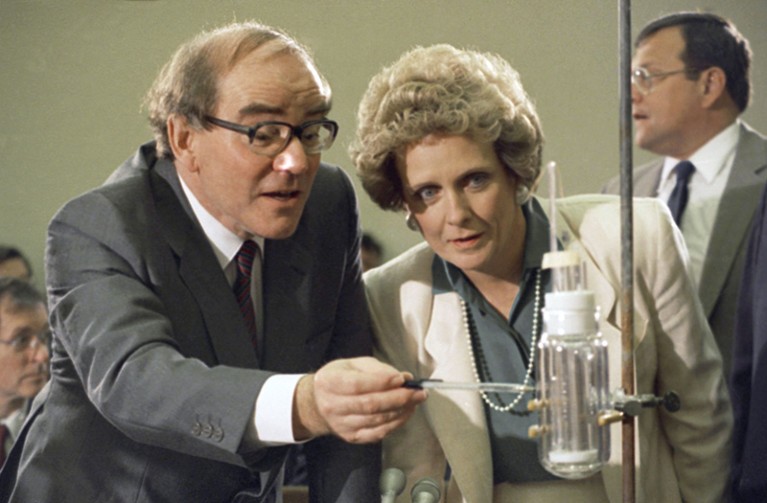Hello Nature readers, would you like to get this Briefing in your inbox free every day? Sign up here.

Chemist Martin Fleischmann (pictured with US politician Marilyn Lloyd) was part of a team that claimed to have produced cold fusion in 1989.Credit: Margot Ingoldsby/AP/Shutterstock
Google has been funding cold-fusion work for four years
Since 2015, Google has funded a group of around 30 researchers across several laboratories to take a fresh look at one of science’s greatest taboos: cold fusion. Specifically, the controversial results reported in 1989 by chemists Martin Fleischmann and Stanley Pons that the thermal energy produced by the electrolysis of heavy water using a palladium cathode exceeded the input electricity. Google’s US$10-million project found no evidence whatsoever of cold fusion, but made some advances in measurement and materials-science techniques.
Despite failing to detect cold fusion, the Google programme was “still a success”, argues a Nature editorial — if only because it might open up a previously no-go area of science to responsible research.
Read the Nature editorial (3 min read)
Pollution cover-ups exposed in Chinese provinces
Local governments in China have been fabricating environmental reports, helping companies to conceal illegal dumping and deceiving central-government inspectors, according to a report by the country's environment ministry. The ministry says that last year it uncovered thousands of violations of environmental regulations across ten provinces. China has been trying to reduce its environmental damage, but the findings show that the country has a way to go to clean up its polluted air, water and soil — a goal of President Xi Jinping.
US government scientists ordered to ignore climate predictions beyond 20 years
The administration of US President Donald Trump is moving to limit the duration of climate-change predictions in the influential National Climate Assessment report. Omitting climate models that go beyond the year 2040 would eliminate any mention of the worst-case case scenarios that will occur if we fail to curb carbon dioxide pollution. Critics see the move as a long-feared response to the last edition of the report, which laid bare the enormous risk to the US economy and livelihoods by the end of the century if current trends in global greenhouse-gas emissions continue.
The New York Times | 10 min read
Reference: National Climate Assessment report (from November)
FEATURES & OPINION
We’re still learning the lessons of cold fusion
Science writer Philip Ball — who was an editor at Nature during the first cold-fusion kerfuffle in 1989 — says that the scars left by the controversy show the dangers of polarization, the distorting influence of commercial interests and the importance of being open about methods, data and mistakes. “Although often held up as a textbook case of science’s self-correcting capacity, the cold-fusion episode is instructive for how it brought out both the best and worst in scientists,” argues Ball.
“Academia is built on exploitation”
The imposing architecture and impressive titles of academia hide a toxic work environment, argues an unnamed researcher in the latest of The Guardian’s Academics Anonymous series. Rogue professors, rampant plagiarism and “mental health issues for PhD students [that] are so common, they could almost be considered part and parcel of the qualification” are just some of the problems that must be addressed, the writer says.
Graphs for humans
Information designer Giorgia Lupi describes her profession as “data humanism”, reports The New Yorker. Lupi describes how infographics and conventional charts have let us down and why “collecting and visualizing your own data is a form of empowerment”.
